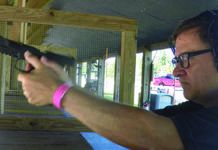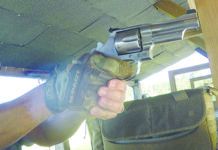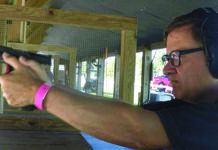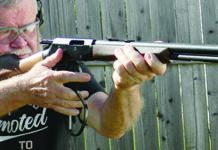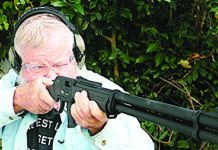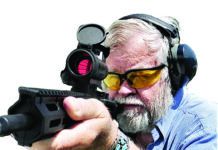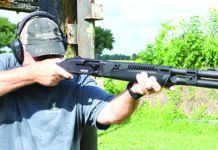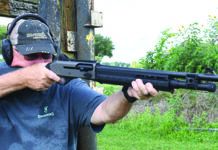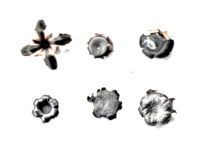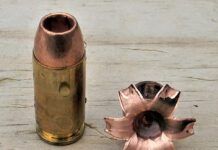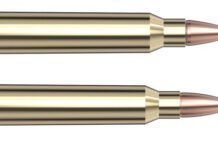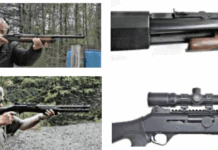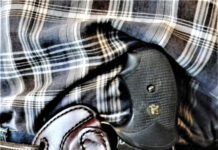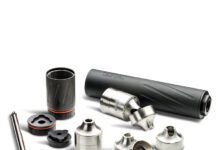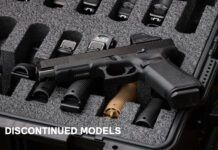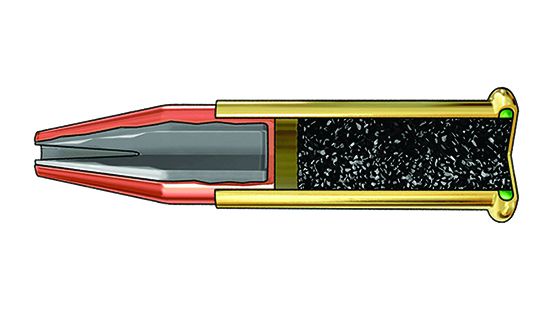On September 18, 2024, Winchester introduced a new rimfire cartridge called the 21 Sharp. The company said the new 21 Sharp rimfire cartridge was purposefully designed to provide top performance with lead-free projectiles rather than accommodating lead-free bullets later. Supposedly, the new cartridge allows for a range of bullet types, including full metal jacket (FMJ), copper matrix, and plated-lead options. Jacketed hollow-point (JHP) bullets will also be available in 21 Sharp, according to Winchester. We wanted to see what was up with this new round, comparing it to existing 22 LR and 22 Magnum choices side by side at the range.
The 21 Sharp design features a slightly smaller bullet diameter that is crimped in place, neatly doing away with the heel-based bullet found in the 22 LR and offering potential for using advanced copper-matrix or jacketed bullets. The 22 Magnum has had jacketed bullets crimped in place for many years, so the technology already existed. Making rifles to fire the 21 Sharp is then, mechanically and in engineering terms, a simple exercise. Existing rifles may be redesigned simply by adding a 21 Sharp barrel. The bolts, extractors, and magazines need not be reconfigured.
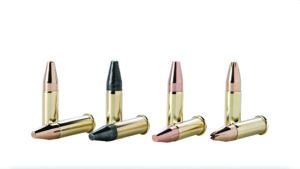
Delving into the round itself, Winchester took a 22 Long Rifle with its .2255-inch-diameter bullet and designed a .2105-inch-diameter bullet to fit neatly inside the existing 22 LR cartridge case. However, the 21 Sharp is not a necked-down 22 Long Rifle at all, but is instead the same cartridge case with a redesigned projectile. Chamber pressure isn’t markedly changed either, so no special metallurgy requirements exist. All improved technology is in the projectile itself.
Winchester is currently the only manufacturer of 21 Sharp ammunition, and Savage chambers the new round in several bolt-action rifles in the B Series F and MK II line. Winchester itself offers the Wildcat Expert bolt-action rifle in 21 Sharp. Ammunition is offered in 25-, 34-, 37-, and 42-grain weights. We were able to obtain a good supply of the 25-grain copper-matrix load early on. It took three months to obtain the 34-grain hollow point through regular commercial channels, and the other two loads were not available as late as February 2025. To compare the two 21 Sharp loads to existing rimfires, we included shooting results from four 22 Long Rifle loads and two 22 Magnum loads.
First, however, let’s look at pricing. At the time of our test, 21 Sharp was available only in 100-round boxes or larger. To simplify the cost comparisons, we’ve broken down the pricing to cost per round. We found the 21 Sharp 25-grain copper matrix round (S21SLF) for $23.59 per 100, or 23.59 cents per round. The 34-grain JHP (X21JHP) was listed for 16.36 cents per round. The 37-grain black plated (X21C) was 14.40 cents a round, though it was wait listed and not available to buy. In comparison, 22 Long Rifle prices were substantially cheaper, with CCI 40-grain AR running 10.33 cents a round, Remington 40-grain LRNs 8 cents/round, and CCI Stingers 21 cents/round. The 22 Magnum rounds we looked at were Armscor 40-grain FMJs 25.62 cents/round, CCI 40-grain FMJs 29.78 cents/round, CCI Maxi-Mag 40-grain JHPs 31.78 cents/round, and CCI TNT 30-grain bullets 35.78 cents/round. So, the 21 Sharp isn’t as inexpensive as many 22 Long Rifle rounds. For performance loads, the price seems comparable to the hot 22 LR rounds. And the 21 Sharp is much less expensive than 22 Magnum.
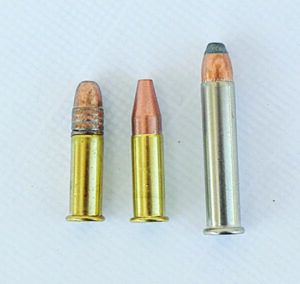
Moving to the range evaluation, we fired four 22 Long Rifle loads, two 22 Magnum loads, and the two 21 Sharp loads we could put our hands on. We fired the 21 Sharp loads in a Savage Mark II F Rifle 21, $253.
The Savage is a little rifle, inexpensive, with a synthetic stock, blued-steel 21-inch barrel, blued-steel receiver, and 10-round magazine. We purchased the rifle from a South Carolina shop in October 2024 and traveled to the range the same day. The first cartridge we fired stuck in the chamber. We rammed the bolt home several times, attempting to force the extractor to catch, but the case would not extract. We used a cleaning rod to knock the case out. The next two cartridges did the same thing. We took it back to the shop, and it was sent back to Savage for repair. By early January our FFL was told they were still waiting for a part. We didn’t want to wait any longer to complete the test, so we ordered another identical rifle and the test proceeded in January 2025. This time we had better results because we were able to fire the rifle successfully.
The supplied steel magazine held 10 cartridges. The magazine was difficult to load past three rounds, and occasionally the first cartridge popped out of place. Our gunsmith-trained rater took a screwdriver and carefully opened the feed lips and rear of the magazine, and we enjoyed good function after this ad hoc modification. At 25 yards, we were able to sight the rifle in for 34-grain loads. The 25-grain high-velocity load struck 2 inches high at 25 yards with the sight ladder in the lowest setting.
We fired for accuracy from a solid benchrest position at 25 yards. The report and recoil were modest and indistinguishable from a 22 Long Rifle load. Accuracy for the 21 Sharp was comparable to the 22 LR but not as consistent as the 22 Magnum readings, but that could easily be differences in the rifles.
Ballistic testing confirmed the 21 Sharp has a low standard deviation, with each cartridge exhibiting less variance between shots than either the 22 LR or 22 Magnum. This may make for greater accuracy potential in a more accurate rifle.
The 21 Sharp offers an advantage over the 22 Long Rifle in muzzle energy, although we don’t know how much practical advantage this will be in the field. The 22 Magnum completely overshadows the performance of either the 22 LR or 21 Sharp, as expected. The highest-rated 22 Long Rifle loading, the CCI Velocitor, exhibited 1380 fps and 169 foot-pounds of energy, while the 34-grain 21 Sharp at 1540 fps went 179 foot-pounds. This isn’t a significant difference in energy. The ultra-fast 25-grain Sharp load went 195 foot-pounds of energy at 1872 fps. Each 22 Magnum load was well over 300 foot-pounds of energy.
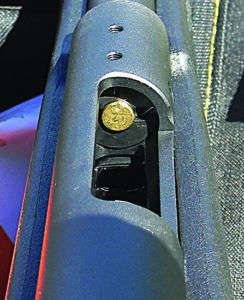
In water testing, we lined up four water jugs, 24 inches of water, and fired the 25-grain 21 Sharp load first. A water depth of 24 inches usually captures any 22 Long Rifle load, but the light Sharp went through all four jugs. We then stacked up six jugs, a total of 36 inches, and fired another round into the jugs at 10 feet distance. The result was again complete penetration. We did not attempt to capture the bullet any further. The entrance and exit holes were of caliber diameter, with little disturbance. Firing the 34-grain jacketed hollow point resulted in what we consider to be excellent performance. The projectile penetrated 10 inches and plumped up to 0.37 caliber. This is good small-game performance. Expansion was greater than any 22 LR load, but only by the slightest margin with the Velocitor 22 LR at 0.35-inch expansion. We also fired the two Sharps into wet newsprint to capture an image of the wound channels. The 25-grain load was a pin prick, while the 34-grain load seemed to open up quickly.
As the test progressed, we enjoyed firing a solid 120 cartridges in a row, then came trouble. A cartridge case stuck in the chamber and was removed with a range rod. Then we enjoyed a full magazine with feed reliability. Then another stuck case. One rifle at the start may have been an exception, but this was the same problem again. Were we rating the Savage bolt-action rifles, both would get F grades since the two failed to function properly.
Our Team Said: After testing the 21 Sharp, we find it to be a pleasant cartridge to fire. Accuracy was good in the economy rifle used in testing, but function leaves a lot to be desired. Whether the round was the problem, or the two Savage rifles were, as a tandem, we can’t recommend them. Perhaps the 21 Sharp will develop into a better, bigger platform over time, but right now, it is no bridge between the 22 LR and 22 Magnum. We can’t see a reason to buy one.
| 21 SHARP, 22 LR, 22 MAGNUM PERFORMANCE DATA | ||||||||||
|---|---|---|---|---|---|---|---|---|---|---|
| Bullet Weight (Grains) | Manufacturer, Brand, and Product Number | Average Velocity (fps) | Standard Deviation (fps) | Muzzle Energy (foot-pounds) | IPSC Power Factor | Average Accuracy (inches) | Expanded Width (inches) | Retained Weight (grains) | Retained Weight (percentage) | Penetration In Water (inches) |
| 25 | 21 Sharp Winchester | 1872 | 10 | 195 | 46 | 1.2 | NA | NA | NA | 36+ |
| 34 | 21 Sharp Winchester | 1540 | 12 | 179 | 52 | 0.8 | 0.37 | 34 | 100% | 10 |
| 32 | 22 LR CC Stinger | 1478 | 37 | 155 | 33 | 1.4 | 0.32 | 30 | 93% | 12 |
| 36 | 22 LR CCI Mini Mag HP | 1222 | 18 | 119 | 44 | 0.8 | 0.33 | 36 | 100% | 18 |
| 37 | 22 LR Winchester Super-X HP | 1238 | 13 | 126 | 46 | 1.1 | 0.29 | 36 | 100% | 18 |
| 40 | 22 LR CCI Velociter | 1380 | 22 | 169 | 55 | 1.3 | 0.35 | 40 | 100% | 20 |
| 30 | 22 Magnum CCI JHP | 2290 | 15 | 349 | 68 | 0.8 | Fragmented | NA | NA | 6 |
| 40 | 22 Magnum CCI Maxi Mag | 1921 | 13 | 328 | 77 | 0.9 | 0.37 | 40 | 100% | 15 |
Notes: Average Velocity and Standard Deviation readings were obtained by firing 20 rounds over a Competition Electronics Pro Chrono. Ambient temperature: 90 degrees. Elevation: 815 feet above sea level. ● The accuracy figures are the average of three five-shot groups. For accuracy, we fired the test gun from a benchrest at a 25-yard target. ● To calculate IPSC power factor, multiply bullet weight in grains by the velocity in fps, then divide by 1000.
Written and photographed by Robert Campbell, using evaluations from Gun Tests Team members. GT




